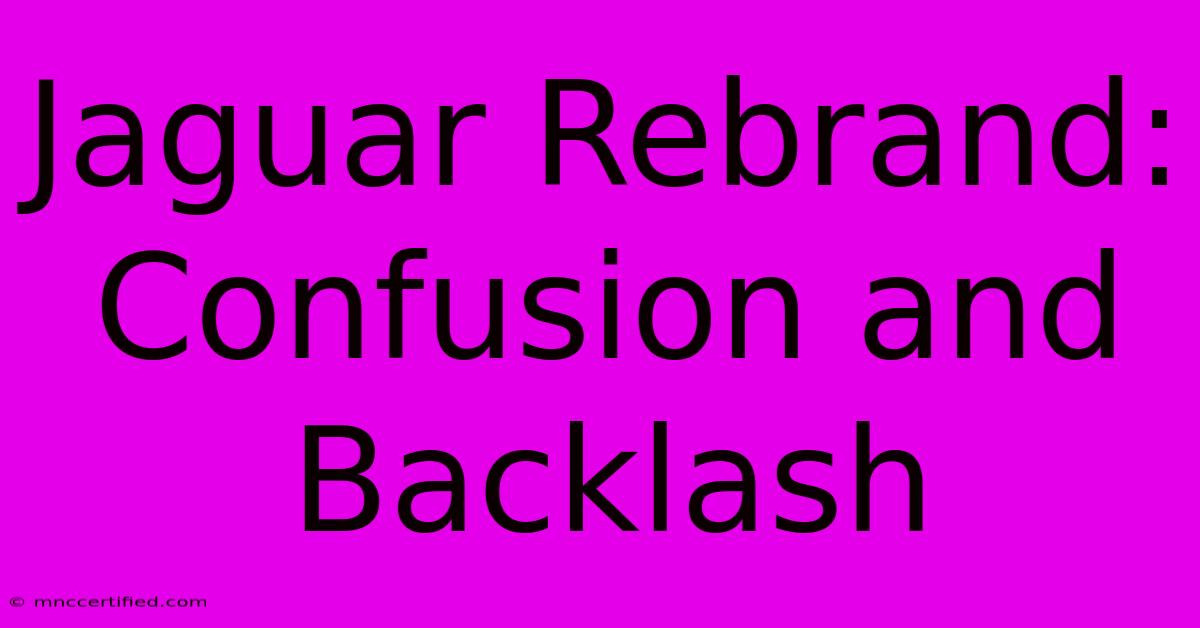Jaguar Rebrand: Confusion And Backlash

Table of Contents
Jaguar Rebrand: Confusion and Backlash – A Brand Identity Crisis?
Jaguar's recent rebranding has sparked considerable debate, generating both confusion amongst consumers and a significant backlash online. This article delves into the reasons behind the negative reception, analyzing the design choices and exploring the broader implications for the luxury car brand.
The New Jaguar Logo: A Source of Contention
The core of the controversy centers around the new Jaguar logo. The simplified, minimalist design, ditching the leaping jaguar for a more abstract and flat representation, has been widely criticized. Many feel it lacks the power and prestige associated with the iconic original. The move away from a recognizable emblem towards a more generic design is seen as a major misstep, diluting the brand's strong visual identity built over decades. Simplicity is not always synonymous with success, and in this case, the simplification seems to have stripped away the core essence of the brand.
Loss of Heritage and Brand Recognition
One of the biggest criticisms is the perceived loss of heritage. The original leaping jaguar logo was instantly recognizable, deeply ingrained in the minds of consumers as a symbol of power, luxury, and British engineering. The new logo, by contrast, is easily overlooked and lacks the same emotional resonance. This could lead to decreased brand recognition and potentially impact sales in the long run. The brand's attempt to modernize feels, to many, like an erasure of its history.
Beyond the Logo: A Broader Rebranding Strategy Under Scrutiny
The negative response extends beyond the logo itself. The overall rebranding strategy, which includes a new typeface and color palette, has also been met with criticism. The changes, while intended to project a more modern image, are viewed by many as inauthentic and inconsistent with the brand’s established personality. Inconsistency in brand messaging can lead to customer confusion and a weakened brand image.
Digital First Approach: A Necessary Evolution or a Miscalculation?
Jaguar's rebranding coincides with a broader shift towards a digital-first approach. While this is a sensible strategy in today's market, the execution has been questioned. The new logo and brand elements may translate well on digital platforms, but their effectiveness in traditional advertising remains uncertain. This lack of holistic brand integration across all platforms further contributes to the negative perception.
The Backlash: Social Media and Public Opinion
The rebranding effort has been met with a storm of negative comments on social media platforms like Twitter and Instagram. Many users have expressed disappointment, describing the new logo as “boring,” “generic,” and a step backward for the brand. This negative online sentiment can be damaging to the brand's reputation and impact sales. The speed at which this negative feedback has spread highlights the importance of thorough market research and careful consideration before implementing such significant changes.
Lessons Learned: Rebranding Requires Careful Consideration
Jaguar's rebranding experience serves as a cautionary tale. It underscores the importance of:
- Thorough Market Research: Understanding your target audience and their expectations is paramount.
- Respecting Brand Heritage: While modernization is essential, it shouldn't come at the expense of losing brand identity.
- Consistent Messaging: All aspects of the rebranding should work together harmoniously.
- Testing and Feedback: Before a full-scale launch, thorough testing and feedback mechanisms are vital.
The Jaguar rebrand demonstrates that a successful rebranding requires a delicate balance between innovation and preserving brand equity. The company's experience highlights the potential consequences of neglecting these critical considerations. The long-term impact remains to be seen, but the initial reaction suggests that Jaguar may have underestimated the importance of its iconic legacy. Only time will tell if this bold gamble will pay off.

Thank you for visiting our website wich cover about Jaguar Rebrand: Confusion And Backlash. We hope the information provided has been useful to you. Feel free to contact us if you have any questions or need further assistance. See you next time and dont miss to bookmark.
Featured Posts
-
Dairyland Insurance Pensacola Fl
Nov 21, 2024
-
Netflix Christmas Chad Michael Murray
Nov 21, 2024
-
Illinois Insurance Card Template
Nov 21, 2024
-
Penn Dot District 10 Winter Road Safety
Nov 21, 2024
-
Parole Hearing Susan Smith Denied Release
Nov 21, 2024